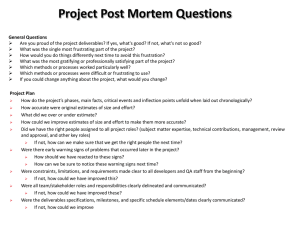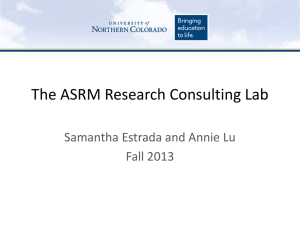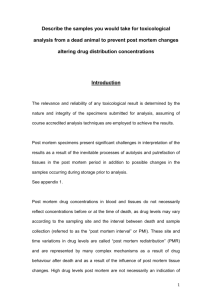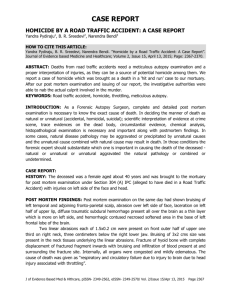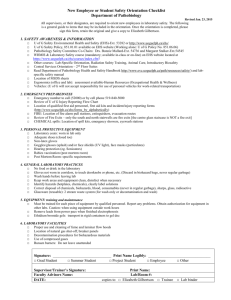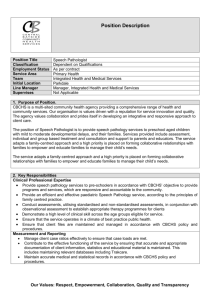Post mortem room code of conduct
advertisement
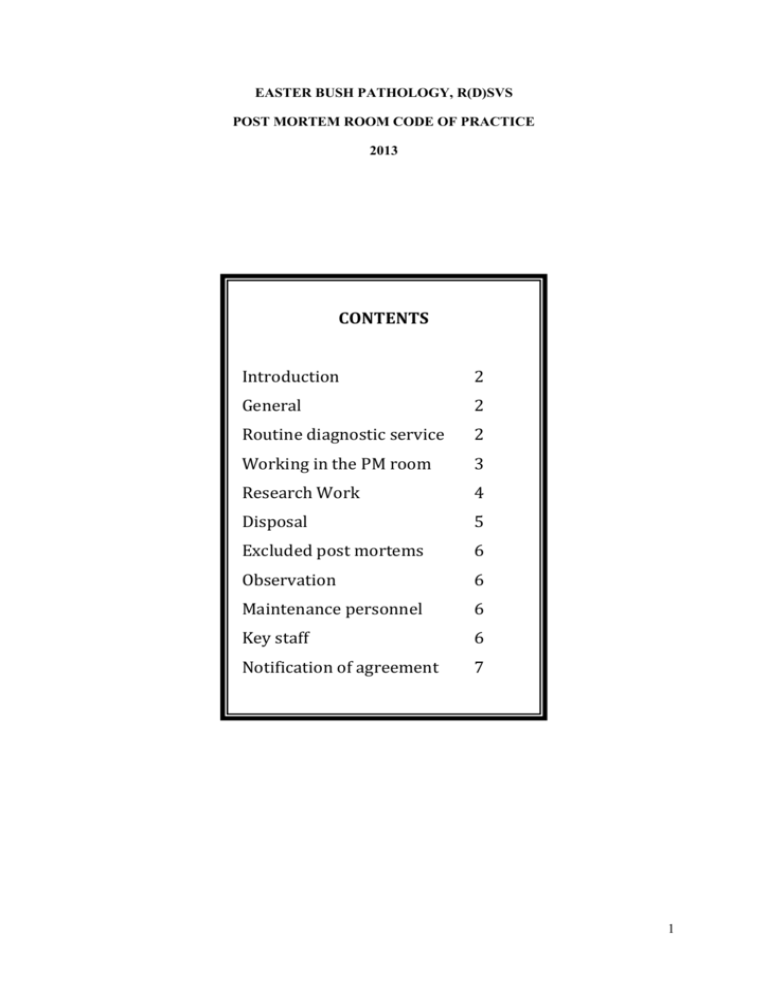
EASTER BUSH PATHOLOGY, R(D)SVS POST MORTEM ROOM CODE OF PRACTICE 2013 CONTENTS Introduction 2 General 2 Routine diagnostic service 2 Working in the PM room 3 Research Work 4 Disposal 5 Excluded post mortems 6 Observation 6 Maintenance personnel 6 Key staff 6 Notification of agreement 7 1 Introduction Easter Bush Pathology (EBP) is keen to encourage submission of cadavers for post mortem examination. For HSE reasons, and to allow efficient running of the post mortem room, we have developed this Code of Practice, the overall aim of which is to make the service work well for everyone and maintain safety standards. General 1. All routine diagnostic post mortem examinations will be carried out by, or under the supervision of, the Duty Pathologist. Wherever possible necropsies will be performed on the day of receipt but the Duty Pathologist is at liberty to prioritise necropsies, after consultation with the submitting clinician(s) so there may be occasions where there has to be a carry-over of cadavers to the following day. Note: Teaching necropsies submitted out of teaching time may be retained frozen until teaching resumes. 2. If you are in doubt as to the procedure for submitting animals or specimens for pathological examination, contact the Head of Anatomic Pathology, Dr Sionagh Smith or in her absence the Duty Pathologist. 3. Post mortem examinations are only done within normal working hours. Please contact the Duty Pathologist in the first instance, though approval by the Head of Anatomic Pathology is also required. 4. Teaching: Bookings for sectional teaching classes to be held in the post mortem room should be made before the start of term through the Head of Anatomic Pathology, not the post mortem room technician. 5. The post mortem room may be available for other activities such as practice or demonstration of a new surgical technique by arrangement. 6. New members of staff are offered an introduction to post mortem room practice (contact Dr Sionagh Smith). Where appropriate, instruction in research related pathological procedures on the post mortem room will be given. Routine Diagnostic Service 1. Internal cadavers for post mortem examination must be entered into Tristan prior to submission, with disposal instructions (routine disposal/private cremation). 2. Cadaver delivery: i) Small companion animals within normal working hours: Please deliver all cadavers to the chill room (G38) and leave on the bottom shelf of the rack just to the right as you enter. 2 ii) Small companion animals outside working hours: Please store cadavers in the HfSA cooler until the following work day. iii) Small ruminants within normal working hours: Please deliver all cadavers to the chill room (G38) and leave on the bottom shelf of the rack just to the right as you enter. iv) Small ruminants outside working hours: Follow procedure as for normal working hours, but OOH swipe card access into the building will be required. Cadavers can be left in the empty bay in the skip disposal room (next to the back door). This is a refrigerated room with motorised roller doors. You will need OOH swipe card access into the building to raise the roller door. Alternatively, ask for access by contacting the Campus Service Centre (Tel: 0131 651 7351 or 0131 651 7352). v) Large animals within normal working hours: Please deliver cadavers for post mortem examination to the back door of the pathology/anatomy wing behind the New Vet School (requires use of covered trailer). vi) Large animals outside working hours: Please deliver cadavers to the empty bay in the skip disposal room (next to the back door). This is a refrigerated room with motorised roller doors. You will need OOH swipe card access into the building to raise the roller door. Alternatively, ask for access by contacting the Campus Service Centre (Tel: 0131 651 7351 or 0131 651 7352). 3. Submission forms (only required for external submissions; internal necropsies should now use Tristan computerised submission): Please leave on tray between the rear entrance to the post mortem room and the chill room. 4. Humane killer devices, barbiturates, needles and syringes MUST NOT be left lying about in the post mortem room. 5. Tissues from post-mortem examinations can be saved on request for up to a day, after which they will normally be discarded, unless retained for use for teaching purposes (e.g. gross rounds, third year practicals), or by agreement. Such requests for retention of tissues should be made at time of carcass submission otherwise tissues will be disposed of at the time of post mortem examination. 6. NO PARTIAL NECROPSIES will be accepted. Under exceptional circumstances, submission of an already opened cadaver must be discussed with the Head of Anatomic Pathology or, in her absence, the Duty Pathologist. Working in the post mortem room 1. Anyone (other than undergraduates under the supervision of pathology staff) working on the post mortem room floor MUST have signed the Notification of Agreement (see page 7). This is an HSE requirement. 3 2. Out-of-hours (OOH) work in the post mortem room is not permitted without the prior permission of the Head of Anatomic Pathology. A specific risk assessment is required and both the Facilities Manager and Safety Officer must be informed. 3. Entry to the post mortem room should either be via the students’ or staff changing rooms. All personnel entering the post mortem room MUST be properly attired in protective clothing and MUST pass through a foot bath. The post mortem room is a potentially infected area. Everyone must wear suitable gowns, gloves and boots. Clothes, boots, etc. used on the post mortem room floor should not be worn elsewhere in the New Veterinary School or Easter Bush Campus. Clinicians using the post mortem room floor area will be expected to change their clinical protective clothing and footwear to dedicated pathology wear. 4. A post mortem examination should not be undertaken until the pathologist has completed a risk assessment and adequate control measures to prevent or minimise any risk of infection are in place. 5. The hoist can only be used by authorised personnel who have received instruction and signed the hoist SOP (see below under Disposal). 6. Blood/body fluid should be washed frequently from gloves during periods of work; perforated or split gloves should be changed and new gloves put on after washing hands. 7. Minimise spray or splash from the hose. 8. Do not run in the post mortem room. 9. Use a cutting board for dissection of tissues and organs. 10. Used needles, still in their sheath, should be disposed of in a sharps container; scalpel blades should be mounted and removed using forceps, not by hand. 11. Used instruments should be placed in detergent (refer to RA1 Cleaning/disinfection in post mortem room). 12. Containers of formalin should be kept covered at all times. 13. All staff including research workers and postgraduate students working in the post mortem room are requested to contribute to the disposal of cadavers and preliminary clean-up at the conclusion of the work period. Users who fail to observe reasonable standards of safety, cleanliness and clean-up in the facility will be denied future access. 14. Wash down waterproof clothing, dispose of gloves in clinical waste bins, thoroughly wash hands and leave the post mortem room through the water baths. Remove boots and leave on dirty side of barrier. Place dirty clothing in laundry. Research Work Research sampling work in the post mortem room must be agreed between Dr Sionagh Smith and the Principal Investigator(s) concerned in writing at the planning stage. It is expected that research workers will provide their own specialist equipment and technical support for sampling or special 4 techniques in the post-mortem room. This work should be planned to take place during normal working hours. Research teams and individuals should liaise with the post mortem room technician (Mr Craig Pennycook) about procedures in the post mortem room. Disposal 1. The skip is for the disposal of cadavers and tissues only. The skip is potentially hazardous and new users or people not conversant with the system should seek advice from the post mortem room technician or Duty Pathologist. Tissues and cadavers for incineration must not be placed in the skip. Personnel must not, under any circumstances, stand on top of skips or enter skips for retrieval of tissues/organs. 2. Organs for disposal must be placed in buckets and transported to the skip area by trolley, to minimise dripping of blood onto the floor of the area to the rear of the post mortem room. 3. Undergraduates are not allowed to operate the hoist mechanism. Postgraduate students, clinical staff and other essential users of the equipment should only use the hoist after instruction from the post mortem room technician and after signing the relevant SOP (to be returned to the Head of Anatomic Pathology). 4. Potential users of the skip with large amounts of animal waste should contact the post mortem room technician prior to using the facility. 5. Out with normal working hours, please follow instructions above (see under Routine Diagnostic Service point 2 above). Animals must not be exsanguinated in the chill room. 6. Horse cadavers must be clearly labelled for disposal, private cremation or post mortem examination by the submitting clinician. Labelling cadavers “not for post mortem examination” would also be helpful. 7. Horses must have horseshoes removed prior to post mortem examination or disposal in the skip. Removal of horseshoes prior to post-mortem examination is the responsibility of VCS staff. 8. Needles must be removed from cadavers. 9. The following must NOT be placed in the skip: (a) Plastic bags or containers, clinical waste, catheters, indwelling needles and drains, metal (horseshoes, etc.), fabric, paper or other non animal tissue (b) Transgenic animals (c) Any radioactive waste 10. If in doubt about any procedures connected with cadaver/organ disposal, please ask. 5 6 Excluded Necropsies It is not possible to undertake post mortem examination of the following at present: 1. Badgers from known TB-affected areas 2. Old World monkeys or apes where there is no knowledge of the primate’s origin and current health status Observation of post mortem examinations Post mortem specimens will be demonstrated to undergraduate students in GEP and years1-4 using the screened in viewing area and sound system Final year students on non-pathology rotations and staff can either view samples using the viewing area or at the rear of the post mortem room, but only with the prior permission of the Duty Pathologist. Please note the area to the rear of the post mortem room is a designated dirty area. Boots must be dipped on entering and leaving. If wearing shoes, these MUST be covered with blue disposable boots. Please dispose of these cover boots in the clinical waste bin provided for this purpose to the rear of the post mortem room. External visitors are only permitted to observe the post mortem area through the viewing area. Maintenance personnel Maintenance personnel requiring access to the post mortem room can only do so when it is not in use and clean. This must be through prior arrangement with the Head of Anatomic Pathology and the School’s Facilities Manager. Key Staff: Head of Anatomic Pathology: Dr Sionagh Smith 50-8787 Post mortem room technician: Craig Pennycook 50-6411 or contact via pager by calling NVS Reception (50-6407) EBP Reception: Renay Brown 51-7458 7 Notification of Agreement Potential users of the post mortem room and biopsy facilities must sign the acknowledgement below and return it to Dr Sionagh Smith. I have read and understood the notes on the post mortem room facilities and related information on post mortem and biopsy submissions. I agree to abide by the “Code of Practice” for the Post Mortem Room. Signed…………………………………. Position …………………………… Print Name………………………………………….. Date………………………………………………… Please return this signed agreement to Dr Sionagh Smith, Easter Bush Pathology, R(D)SVS. Please note, in compliance with Health and Safety Rules of the University, if you have not signed this form you will not be able to use the Post Mortem Room facilities. 06/06/13 8
